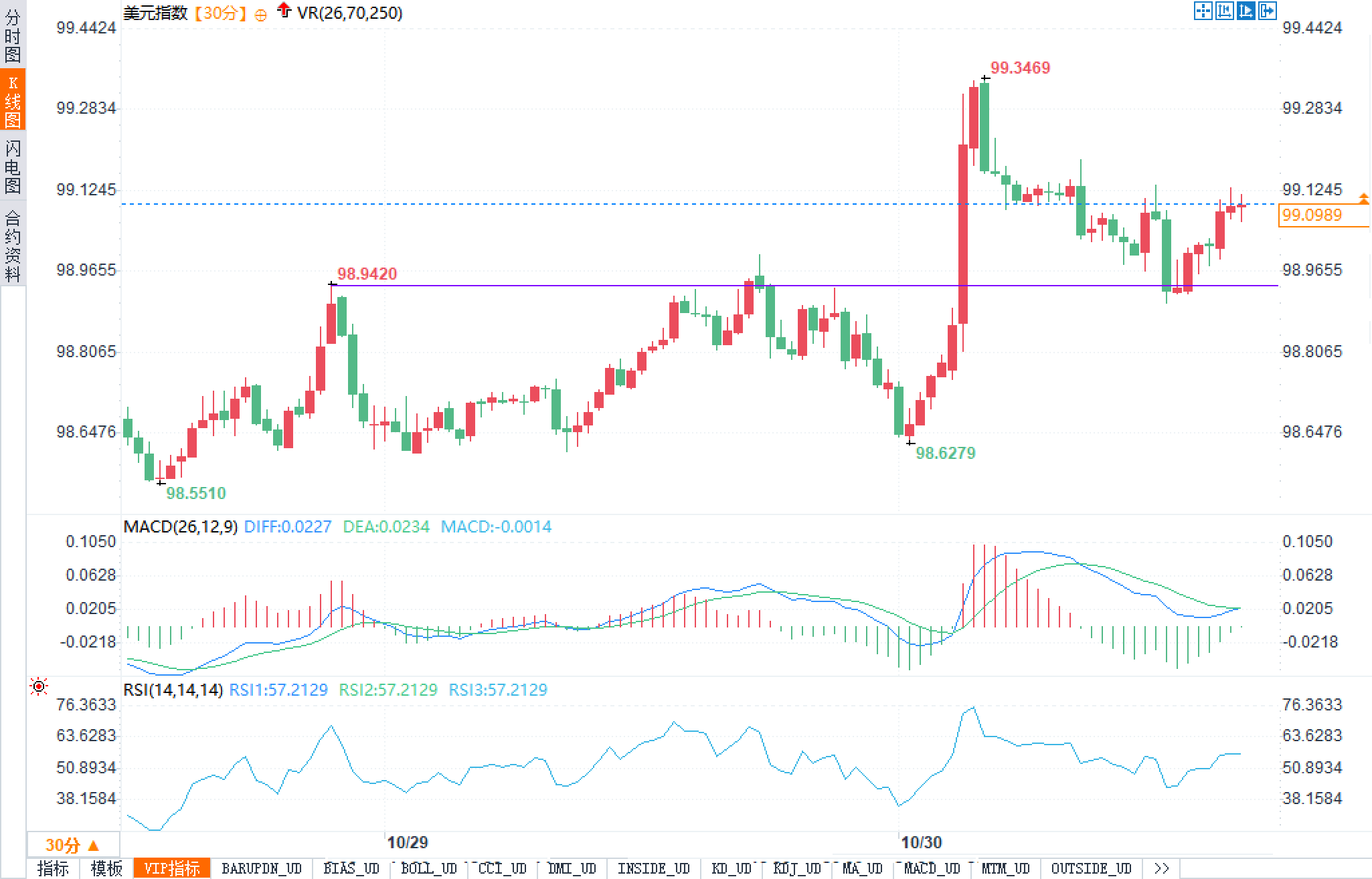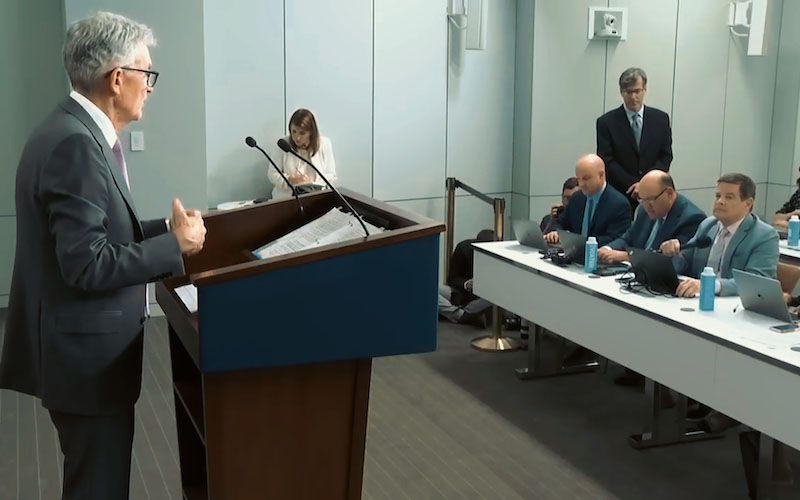Signals of a US dollar peak are mixed: a short-term rebound is likely, but a deep fall is unlikely? The 99 level continues to be a point of contention.
2025-10-30 16:28:22

From a macroeconomic and policy perspective, the Federal Reserve's recent reduction of the federal funds target range to 3.75%–4.00%, and its repeated emphasis at the press conference that it "would not pre-determine a course," essentially shifts the uncertainty from "direction" to "conditions." On the one hand, most members in the September dot plot marked the "neutral" range at 3%–4%, meaning the nominal policy rate is approaching a band that neither stimulates nor significantly suppresses growth. On the other hand, the Chairman still described the current stance as "moderately tight," highlighting a clear division within the committee regarding "whether another round of easing is needed soon": some members advocate for a larger, one-off rate cut to stabilize growth and mitigate risks in the short term; others emphasize that the labor market has not deteriorated significantly and that excessive forward easing is inappropriate given insufficient evidence. Such disagreements are not necessarily bad; rather, they mean that data before December will have greater "interpretive power," rather than being merely "captured" by policy inclinations.
The "misalignment" between prices and employment is the main theme of current discussion. Excluding tariff shocks, inflation is not far from the target range; core PCE remains above the target but is marginally declining; and housing services inflation is cooling. Meanwhile, employment has not weakened significantly, and structural factors on the labor supply side make the assessment of "tightness" more dependent on specific factors. In other words, the macroeconomic picture presents a combination of "gradually weakening inflationary pressures and no signs of slowing growth or employment." Within this framework, both "further cuts to achieve a more neutral policy position" and "pausing observation to await data confirmation" have logical support, leading to a more balanced market pricing for December. This balance directly points to the core pricing factors of the US dollar index—the front-end real interest rate differential and the path uncertainty premium: the former provides support, while the latter suppresses trend-based unilateral movements.
On the balance sheet front, the FOMC decided to suspend quantitative tightening starting in December and proactively shorten asset duration and improve the match with the duration structure of existing Treasury bonds by primarily reinvesting maturing funds in U.S. Treasury bills. The impact on the dollar is not one-way: First, the suspension of balance sheet reduction marginally improves liquidity conditions within the dollar system, potentially lowering term premiums in the medium to long term, thus offsetting the ebb and flow of the dollar's "interest rate differential – liquidity" relationship. Second, nominal interest rates remain relatively firm against the backdrop of "increased uncertainty regarding interest rate cuts," providing coupon support for the dollar in the short term. Third, reserves passively decline as other liability items naturally expand, meaning excess reserves will not immediately expand again, and the "easing of liquidity" in the dollar is gradual. Therefore, the dollar index is more likely to enter a period of high-frequency fluctuations and rhythm shifts amidst the tug-of-war between "interest rate differential support – marginal improvement in liquidity," rather than a one-way movement.
Returning to market performance and structural characteristics, the linkage between interest rates and exchange rates was clearly evident last night: during the Q&A session of the press conference, the yields of US Treasury bonds from 2 years to 30 years generally rose, the yield curve flattened in a bearish manner, and the implied magnitude of another rate cut in December by interest rate futures dropped from "the whole hour" to "a fraction of a second," thus providing the US dollar with temporary interest rate differential support.
From a longer-term structural perspective, whether the dollar's strong cycle has peaked depends on whether three chains can simultaneously reverse: First, whether the real interest rate differential can continue to decline and be "confirmed" by the market; second, whether the term premium of the US nominal-real interest rate curve can shift significantly downward with marginal improvements in liquidity; and third, whether the "right side of the fundamentals" of major counterpart currencies—the policies and growth trajectories of the European Central Bank, the Bank of England, and the Bank of Japan—can provide stable valuation anchors. Currently, the first chain has not yet been met (uncertainty regarding front-end interest rate cuts has increased), the second chain is halfway through "gradual but improving liquidity," and the third chain is still in the midst of a data and policy game. Therefore, the dollar index is more like being in a range-bound phase where "rising is difficult and falling is not deep."
Technical aspects
The 30-minute chart shows that the US dollar index formed a low near 98.63 before quickly rising to 99.35, then retracing and consolidating around 99.10, exhibiting a "V-shaped rebound + high-level consolidation" structure. The MACD is above the zero line, but the histogram has turned from red to green, and the DIFF and DEA lines are converging, indicating that upward momentum is weakening but the trend has not yet been broken. The RSI is around 57, in the neutral-to-strong zone, not showing signs of overheating.

In terms of price levels, the price is still under pressure at 99.35; on the downside, 98.94 is the neckline support level after the previous high was tested, and further support lies in the low zone of 98.63/98.55. Overall, the market is in a strong consolidation pattern, and the future direction depends on how the price handles the 99.10-99.35 range and whether the momentum can amplify again.
- Risk Warning and Disclaimer
- The market involves risk, and trading may not be suitable for all investors. This article is for reference only and does not constitute personal investment advice, nor does it take into account certain users’ specific investment objectives, financial situation, or other needs. Any investment decisions made based on this information are at your own risk.





















